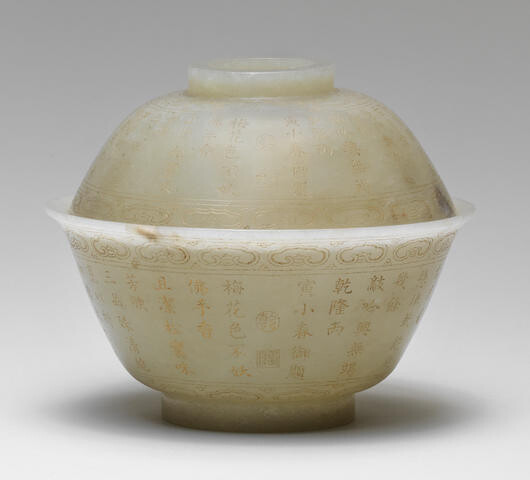A very rare pale green jade Imperial-inscribed 'tea of three purities' tea bowl and cover
Qianlong four-character mark and of the period
Qianlong four-character mark and of the period
The translucent jade expertly carved with deep rounded sides to a flaring rim from a short straight foot, incised and gilt around the exterior with a poem composed by the Qianlong emperor that ends with a Bingyin cyclical date (corresponding to 1746) and followed by two seals, Qian and Long, all enclosed between two borders of ruyi-heads, the domed cover similarly incised with the same text, the semi-transparent stone with frost-like inclusions, zitan stand. 11.2cm (4 3/8in) diam. (3).
清乾隆 御製青白玉刻「三清茶」詩蓋盌
「乾隆年製」隸書刻款
Provenance: a Swiss private collection
來源:瑞士私人收藏
It is rare to find inscribed jade tea bowls, as a number of these were usually made of porcelain, either decorated in underglaze blue or iron red. Compare with two porcelain bowls similarly decorated, the first in the collection of the National Palace Museum, Taipei, illustrated in Empty Vessels, Replenished Minds: The Culture, Practice and Art of Tea, Taipei, 2002, p.152, no.129; and another also in the National Palace Museum, Taipei, illustrated in Emperor Qianlong's Grand Cultural Enterprise, Taipei, 2002, p.51, no.I-40.
The poem on the current bowl, Sanqing cha (三清茶), 'Tea of Three Purities', was composed by the Qianlong Emperor. It has been mentioned that the Qianlong emperor was an avid drinker of tea, and in the 11th year of his reign (1746) on his return from visiting Mount Wutai, Shanxi Province, his entourage sojourned to make tea using fallen snow. In the brew, as well as Longjing tea leaves, were the three additions of prunus, pine nut kernels and finger citrus. It was this concoction that inspired the emperor to compose the present poem 'Tea of Three Purities'.
The poems on the cover and body are the same and were published in Yuzhishi chuji (Imperial Poems I) (1736-1747). Following the poem, the bowl and cover are inscribed Qianlong bingyin xiaochun yuti, 'inscribed in October of the Bingyin year of Qianlong' corresponding to 1746, following two seals, Qian long. The subject of the poem confirms that this bowl and cover was used specifically for drinking tea.
Compare with a related white jade tea bowl and cover, Qianlong six-character seal mark and of the period, with the same poem, which was sold at Christie's Hong Kong, 26 November 2014, lot 2931.
View it on
Sale price
Estimate
Time, Location
Auction House
Qianlong four-character mark and of the period
Qianlong four-character mark and of the period
The translucent jade expertly carved with deep rounded sides to a flaring rim from a short straight foot, incised and gilt around the exterior with a poem composed by the Qianlong emperor that ends with a Bingyin cyclical date (corresponding to 1746) and followed by two seals, Qian and Long, all enclosed between two borders of ruyi-heads, the domed cover similarly incised with the same text, the semi-transparent stone with frost-like inclusions, zitan stand. 11.2cm (4 3/8in) diam. (3).
清乾隆 御製青白玉刻「三清茶」詩蓋盌
「乾隆年製」隸書刻款
Provenance: a Swiss private collection
來源:瑞士私人收藏
It is rare to find inscribed jade tea bowls, as a number of these were usually made of porcelain, either decorated in underglaze blue or iron red. Compare with two porcelain bowls similarly decorated, the first in the collection of the National Palace Museum, Taipei, illustrated in Empty Vessels, Replenished Minds: The Culture, Practice and Art of Tea, Taipei, 2002, p.152, no.129; and another also in the National Palace Museum, Taipei, illustrated in Emperor Qianlong's Grand Cultural Enterprise, Taipei, 2002, p.51, no.I-40.
The poem on the current bowl, Sanqing cha (三清茶), 'Tea of Three Purities', was composed by the Qianlong Emperor. It has been mentioned that the Qianlong emperor was an avid drinker of tea, and in the 11th year of his reign (1746) on his return from visiting Mount Wutai, Shanxi Province, his entourage sojourned to make tea using fallen snow. In the brew, as well as Longjing tea leaves, were the three additions of prunus, pine nut kernels and finger citrus. It was this concoction that inspired the emperor to compose the present poem 'Tea of Three Purities'.
The poems on the cover and body are the same and were published in Yuzhishi chuji (Imperial Poems I) (1736-1747). Following the poem, the bowl and cover are inscribed Qianlong bingyin xiaochun yuti, 'inscribed in October of the Bingyin year of Qianlong' corresponding to 1746, following two seals, Qian long. The subject of the poem confirms that this bowl and cover was used specifically for drinking tea.
Compare with a related white jade tea bowl and cover, Qianlong six-character seal mark and of the period, with the same poem, which was sold at Christie's Hong Kong, 26 November 2014, lot 2931.



